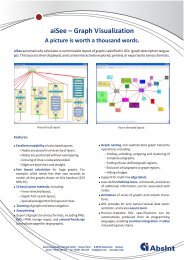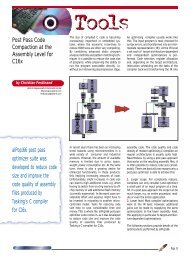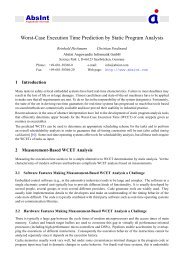5 Graph Description Language (GDL) - Absint
5 Graph Description Language (GDL) - Absint
5 Graph Description Language (GDL) - Absint
You also want an ePaper? Increase the reach of your titles
YUMPU automatically turns print PDFs into web optimized ePapers that Google loves.
4.1.4 Edge Classes - Expose/Hide Edges<br />
The edges of a graph can be partitioned statically into edge classes by providing an integer for each<br />
edge. Edges with the same integer form a class. These edge class numbers appear in the Select<br />
Edge Classes dialog box. Instead of the numbers the <strong>GDL</strong> specification can provide names for<br />
edge classes, e. g. if a syntax tree with type information is visualized the edge classes could be<br />
“type edges” and “syntax tree edges”.<br />
After selecting Expose/Hide Edges... in the Folding menu the Select Edge Classes dialog<br />
box appears (see Figure 8). The box shows all the edge classes present.<br />
Edges of enabled edge classes and their target nodes are drawn in the graph window. Edges of<br />
disabled edge classes and all nodes accessible via these edges are not drawn and are not considered<br />
in the layout calculation of the graph.<br />
4.1.5 Subgraph<br />
Figure 8: Edge Class Menu<br />
A graph can be partitioned into nested subgraphs. Subgraphs can be defined only statically, i. e. in<br />
the graph specification. In the <strong>GDL</strong> specification, subgraphs should be specified in such a manner<br />
so that the user can identify subgraphs and summary nodes and thus make use of all the operations<br />
that work on subgraphs.<br />
Operations: Subgraphs can be<br />
27





